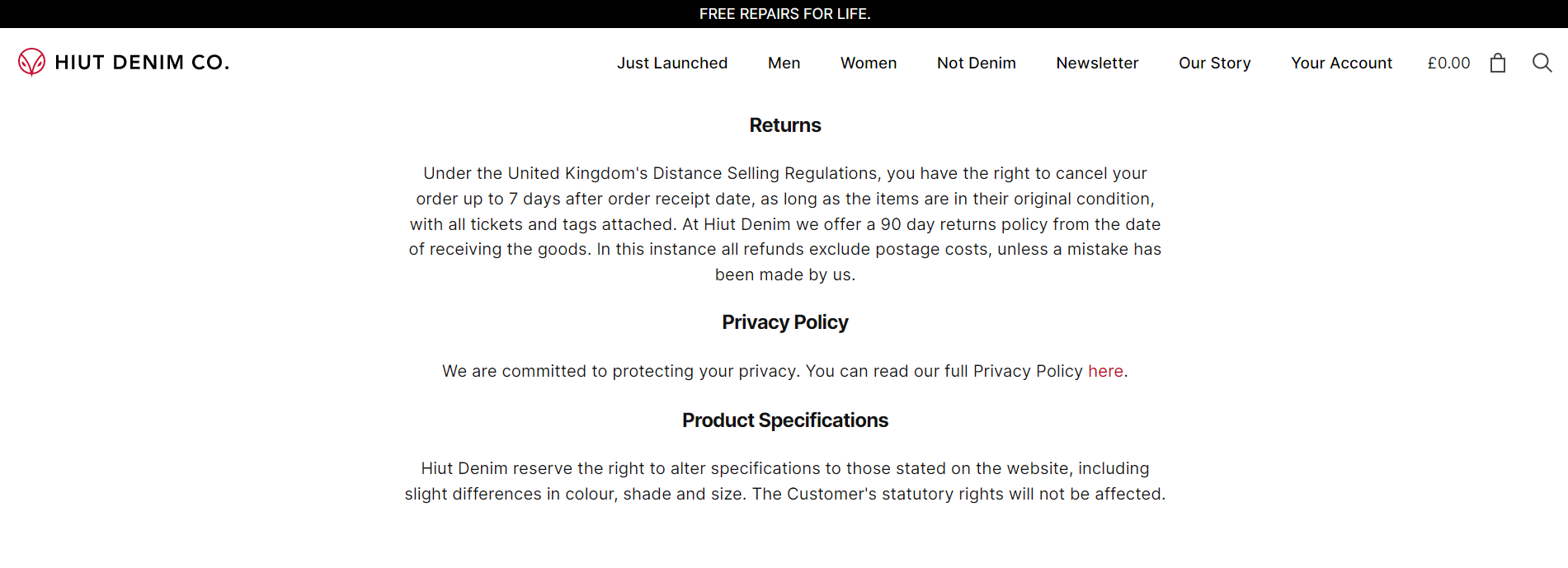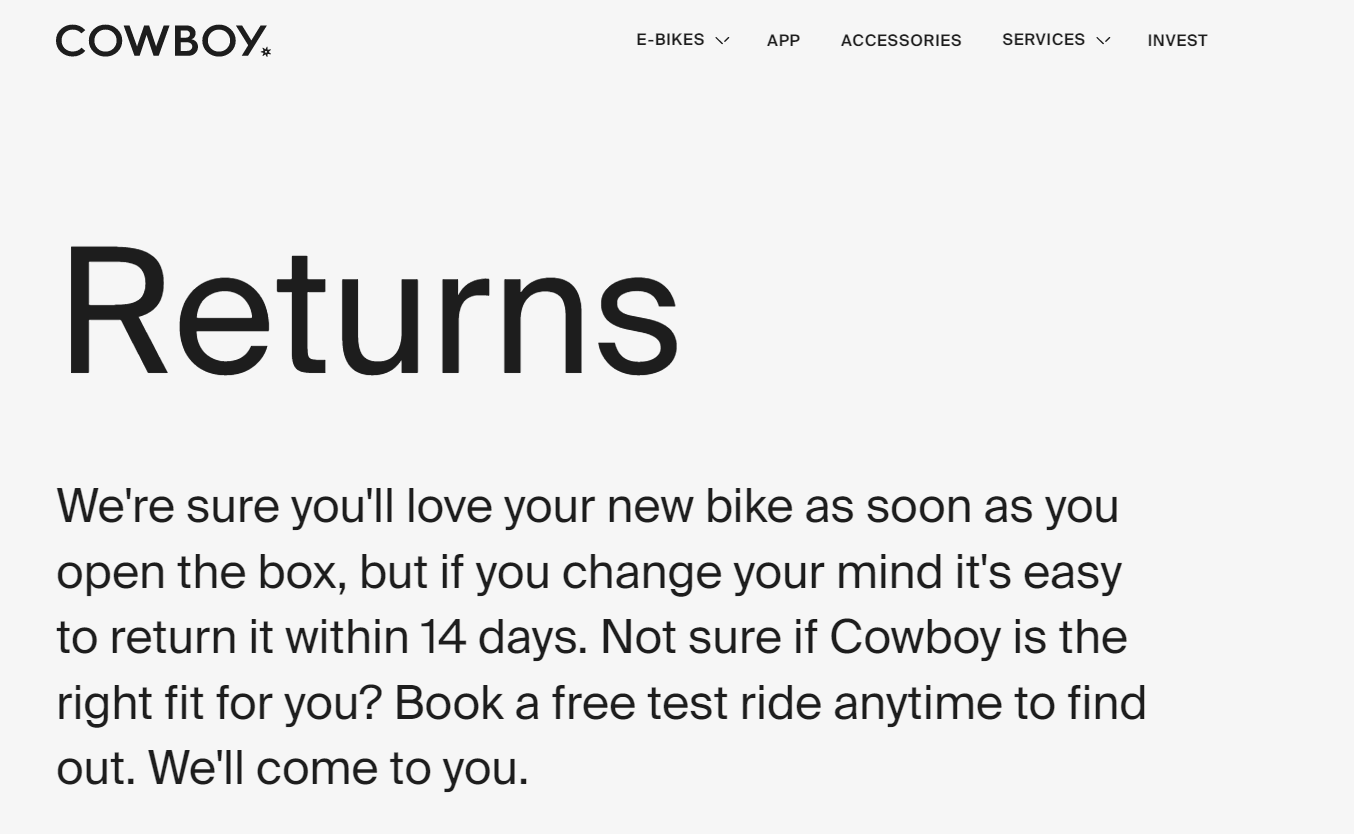Returns are an inevitable part of any eCommerce business, and a well-crafted return policy is crucial for providing a seamless customer experience. A clear and concise return policy can also help to build trust and confidence with your customers, which can translate into increased sales and customer loyalty.
In this article, we will explore the definition and basic elements of a return policy, as well as provide Shopify return policy examples for popular categories. Additionally, we’ll share some tips on how to make a great return policy that meets the needs of both your business and your customers. Whether you are just starting out or looking to refine your return policy, we provide you with all the information you need to create a customer-friendly and profitable return policy.
Table of Contents
Definition and Basic Elements of A Return Policy
A return policy is a set of guidelines and procedures that dictate how a business handles product returns and refunds. It is an essential part of any eCommerce business, including Shopify stores. A clear and comprehensive return policy not only sets expectations for customers but also protects the business from fraudulent or abusive return practices. Here are some of the basic elements that should be included in a return policy:
- Timeframe: Clearly specify the timeframe within which returns are accepted, such as 14, 30, or 60 days from the purchase date.
- Condition: Outline the condition in which items must be returned, such as unopened or in the original packaging. You can also list any items that cannot be returned, such as final sale items or personalized products.
- Refund or Exchange Options: Describe the options available to customers for refunds or exchanges, such as receiving a full refund or exchange for a different product. Specify the method of refund, whether it be store credit, exchange, or a refund to the original payment method.
- Shipping and restocking fee: Explain who will be responsible for the shipping costs associated with the return, and state whether there is a restocking fee for returned items.
For Shopify store owners, creating a return policy can be done easily through the platform’s settings. It is important to consider factors such as the timeframe for returns, the acceptable condition of returned items, and refund or exchange options. By having a clear and fair return policy, Shopify store owners can provide a positive shopping experience for their customers while protecting their business.
Shopify Return Policy Examples for Popular Categories
Recently, Shopify made a list of Top 50 Great Shopify eCommerce Stores to Inspire You (2024), let’s take a look at the top most popular store in their return policies.
Shopify Return Policy Examples for Clothing and Fashion Stores – Hiut Denim Co
Laying at the top of the list of 50 Great Shopify eCommerce Stores to Inspire You (2023) by Shopify, Hiut Denim Co is a clothing and fashion store based in Cardigan, Wales. Founded in 2011, the store aims to showcase the skills and know-how of locals in jean-making and bring manufacturing back to Cardigan. The store is dedicated to making high-quality jeans, rather than focusing on quantity. The factory closure in Cardigan left many skilled people without work, which inspired the creation of Hiut Denim Co to breathe new life into the town. Let’s take a look at the company’s terms and conditions.

- Return window: Hiut Denim Co. offers a 90-day return policy from the date of receiving the goods, which is significantly longer than the 7-day period required by the Distance Selling Regulations in the UK.
- Condition of the item: To be eligible for a refund, items must be in their original condition with all tickets and tags attached.
- Refund or exchange policy: Hiut Denim Co. offers refunds for all returned items.
- Shipping fee: The customer will have to pay postage costs unless a mistake was made by the company.
Shopify Return Policy Examples for Art and Handmade Goods Stores – Silk and Willow
Another company in the list of 50 Great Shopify eCommerce Stores to Inspire You (2023) by Shopify, Silk and Willow is a sustainable wedding decor boutique that offers bespoke details for environmentally conscious couples. They create luxury and high-quality products using ancient dyeing methods and botanically-dyed colors without compromising the planet. Silk and Willow’s mission is to provide a shopping experience that aligns with their customer’s respect for Mother Nature.

- Return window: Silk & Willow accepts unused returns within 10 days of purchase.
- Condition of the item: Items must be in their original condition to be eligible for return. Used or non-original condition items will be subject to a re-stocking fee.
- Refund or exchange policy: Once the product is received in its original condition, store credit will be issued for the amount of the purchased product. Custom orders are non-returnable. If there is an error in the shipment, Silk & Willow will resolve it promptly.
- Shipping fee: Customers are expected to use and pay for their preferred shipping themselves, but Silk & Willow recommends using trackable shipping.
Shopify Return Policy Examples for Electronic and Gadget Stores – Cowboy
Finally, Cowboy is an electronic and gadget store that specializes in selling smart eBikes. They offer an immersive shopping experience through high-quality videos and photos on their Shopify store. Customers can also book a test ride to try the product before making a purchase. Cowboy aims to revolutionize daily commuting by providing high-speed, comfortable, and convenient travel around the city. They achieve this by integrating intelligent technology, meticulous service, and delightful design.

- Return window: Cowboy offers a full refund within 14 days of delivery, minus other fees.
- Condition of the item: The bike should be in the original packaging, in perfect condition, and must not have been assembled or used. Accessories or spare parts purchased on their website should be unused, sealed in their original packaging, and in a resalable condition.
- Refund or exchange policy: If the bike has been assembled or used, they will charge a loss of value fee of up to €500. Accessories or spare parts can be returned within a 14-day period after delivery.
- Shipping fee: The return shipping cost, along with the packaging and loss of value fee usually being paid by customers, but in some cases, Cowboy will reconsider.
How to write a Return Policy for your Shopify store
Introduction:
- Purpose: Briefly explain the purpose of your return policy.
- Customer Assurance: Emphasize your commitment to customer satisfaction.
Eligibility Criteria:
- Time Frame: Specify the time frame within which returns are accepted (e.g., 30 days from purchase).
- Condition of Items: Describe the condition items must be in to be eligible for return (e.g., unused, with original tags, in original packaging).
Non-Returnable Items:
Exceptions: List items that cannot be returned (e.g., perishable goods, custom products, intimate or sanitary goods).
Process for Returns:
- Initiating a Return: Provide instructions on how to initiate a return (e.g., contacting customer service, or filling out a return form).
- Return Authorization: Mention if a return authorization is required before sending items back.
- Return Shipping: Clarify who is responsible for return shipping costs and how to handle return shipping (e.g., prepaid label, customer’s choice).
Refunds:
- Refund Method: Explain how refunds are processed (e.g., original payment method, store credit).
- Processing Time: State the time frame for processing refunds once the returned item is received.
- Partial Refunds: Outline scenarios where partial refunds might be issued (e.g., item not in original condition).
Exchanges:
- Exchange Process: Detail the process for exchanging items if applicable.
- Stock Availability: Note that exchanges are subject to stock availability.
Damaged or Defective Items:
- Reporting Damages: Instruct customers on how to report damaged or defective items.
- Proof of Damage: Specify if photos or other proof are required for damage claims.
- Replacement or Refund: Explain whether customers can choose a replacement or refund for damaged items.
Contact Information:
- Customer Support: Provide contact details for customer support (e.g., email, phone number).
- Business Hours: Include the hours during which customer support is available.
Additional Information
- Policy Updates: Mention that the return policy is subject to change and advise customers to review it periodically.
- Legal Compliance: Ensure the policy complies with relevant consumer protection laws.
Tips for Making A Great Return Policy
Keep It Simple and Easy To Understand
Keeping the Return Policy simple and easy to understand is a great tip for making a great Return Policy. Customers should be able to easily comprehend the terms and conditions of the policy without confusion or ambiguity. Using clear language and avoiding overly technical jargon can make the policy more accessible to customers of all backgrounds and education levels. Additionally, presenting the policy in a format that is easy to navigate, such as using bullet points or numbered lists, can also help customers quickly find the information they need.
Easy-to-understand languages
One of the most important tips for making a great return policy is to keep the language simple and easy to understand. Try to avoid using legal or technical jargon that may confuse your customers. Use plain language that your customers can understand, and clearly state your policies without any ambiguity. Using bullet points or lists can also help to make your policy more clear and easy to read. By keeping your policy easy to understand, you’ll not only reduce customer confusion but also help to build trust and confidence in your brand.
Logical outline
Another key tip for creating a great return policy is to provide a logical outline of your policy. This means organizing your policy in a way that is easy to follow and understand. Start by outlining the basics, such as the return window and the condition of the item. Then, clearly state your refund or exchange policy and who pays for shipping. Finally, include any additional information, such as exclusions or special circumstances. By providing a logical outline, you’ll make it easier for your customers to find the information they need and reduce the likelihood of any confusion or misunderstandings.
Be Transparent and Clear About Your Policies
- Clearly state your policies: Make sure that your return policy is easy to find and understand. It should be prominently displayed on your website, ideally in the footer or checkout page.
- Explain the process upfront: Outline the steps that customers need to take to return or exchange an item. This should include information on how to initiate a return, where to send the item, and how long it will take to process the return.
- Be clear about eligibility: State what items are eligible for returns or exchanges and any conditions that must be met, such as items being in their original packaging, unused or unopened.
- Be upfront about costs: Clearly explain who will bear the costs of the return, including shipping and handling fees. If you offer free returns, make this clear on your website.
Consider Your Target Audience and Industry
Crafting a return policy that works for both your business and your customers requires careful consideration of your target audience and the industry you operate. When developing your policy, it’s important to keep in mind the unique needs and preferences of your customers, as well as any industry-specific practices and regulations that may affect your policy.
For example, the return policy for a clothing store may differ from that of a furniture store. Clothing stores may allow for more flexible returns and exchanges, as customers may need to try on items or may be unhappy with the fit or style. On the other hand, furniture stores may have more strict policies due to the high cost and difficulty of shipping and storing large items.
In addition to industry-specific factors, the preferences of your target audience should also be taken into account. Younger consumers may prefer a more flexible return policy, as they may be more likely to shop online and may be more accustomed to easy returns. Older consumers, on the other hand, may prioritize a more straightforward policy that they can easily understand.

Researching and analyzing your competitors’ return policies can also help you create a policy that is competitive and attractive to potential customers. Look at how other businesses in your industry handle returns and exchanges and consider what aspects of their policies may be successful or problematic. You can use this information to create a policy that sets you apart from your competitors and meets the needs and expectations of your target audience.
Invest The Best in Customer Support
This might be outside the context of making a great return policy, but when it comes to making a great customer experience, investing in top-notch customer support can go a long way in ensuring customer satisfaction. Great customer support includes providing detailed information for customers, readiness to help customers, and making it easy for customers to initiate after-sales support.
Provide detailed information for customers
Providing detailed information for customers is key to making a great return policy. Customers need to know what to expect, not only details about products but also about the store policies like when can they return a product, including the condition of the item and refund or exchange policy. By offering this information upfront, businesses can avoid confusion and help customers make more informed decisions.
Always have personnel ready to help customers during checkout
In addition to providing detailed information, businesses should also have personnel readily available to help customers during checkout. Whether it’s answering questions about the return policy or assisting with a specific product inquiry, having knowledgeable staff available to help can greatly improve the customer experience, which leads to increased customer satisfaction and even repeat sales.
Make it easy for customers to initiate after-sales support
Finally, making it easy for customers to initiate after-sales support is crucial. This can include providing a clear and simple process for initiating returns or exchanges and offering multiple channels for contacting customer support like email, phone, or live chat, and responding promptly to customer inquiries. By making it easy for customers to get the help they need, you can build trust and loyalty with your customer base.
Common questions about Return Policy for your Shopify store
Can an Online Store Have a No Return Policy?
Yes, an online store can have a no return policy, but it’s important to clearly communicate this policy to customers before they make a purchase. Transparency is key to maintaining customer trust and satisfaction. If you choose to implement a no return policy, consider the following:
- Clearly Display the Policy: Ensure that the no return policy is prominently displayed on your website, especially on product pages and during the checkout process.
- Detail Exceptions: Specify any exceptions to the no return policy, such as defective or damaged items.
- Legal Compliance: Ensure that the policy complies with consumer protection laws in the regions where you operate. Some jurisdictions have specific regulations that may require refunds or returns for certain types of purchases.
How do I handle return shipping costs in my return policy?
Typically, you can specify that customers are responsible for return shipping costs unless the item is defective or damaged. Offering a prepaid return label can enhance customer satisfaction but may increase costs for your business.
How Do I Calculate eCommerce Return Rate?
Calculating your eCommerce return rate is straightforward and involves the following formula:

Here’s a step-by-step guide:
- Determine the Number of Returned Items: Count the total number of items that were returned within a specific period.
- Determine the Total Number of Sold Items: Count the total number of items sold within the same period.
- Apply the Formula: For example, if you sold 1,000 items in a month and 50 items were returned, the return rate would be:

Is It Illegal Not to Give a Refund?
Whether it is illegal not to give a refund depends on the jurisdiction and the specific circumstances of the sale. Here are some general guidelines:
- Consumer Protection Laws: Many countries have consumer protection laws that require businesses to provide refunds under certain conditions, such as for defective or misrepresented products. For example, in the United States, The Federal Trade Commission (FTC) requires refunds for defective goods or goods that are not as advertised. In the European Union, the Consumer Rights Directive gives customers the right to cancel and return goods within 14 days for a full refund, known as the cooling-off period.
- Business Policies: Even if not legally required, offering refunds can be a good business practice to maintain customer satisfaction and trust.
- Exceptions: There are exceptions to refund requirements, such as Custom or personalized items; Perishable goods or Digital products (once downloaded or used)
Conclusion
In conclusion, a well-crafted return policy is essential for any successful eCommerce store. It can not only help build trust with customers but also increase sales and reduce the risk of negative reviews. By following the Shopify return policy examples and tips we’ve provided in this blog, you can create a return policy that meets the needs of both you and your customers. Remember, a good return policy is a win-win for everyone involved.
If you meet any obstacle in the process of building your own Shopify store return policy, you can reach out to our Shopify experts. With more than 8+ years of providing website development services, Magenest has plenty of specialists who have comprehensive knowledge and best practices, they can give you thorough consultancy and suggestions.











